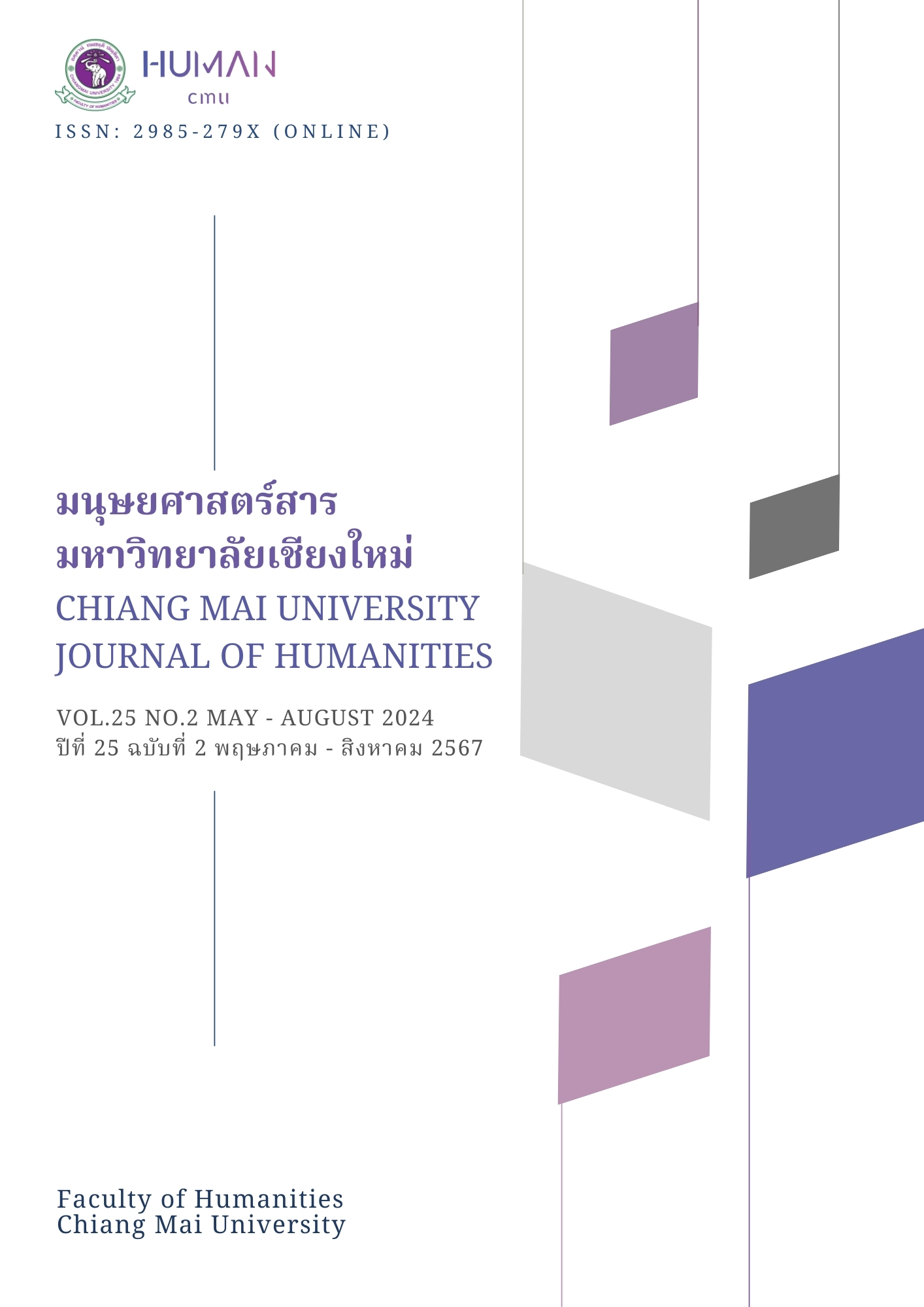แนวทางการพัฒนาการท่องเที่ยวเชิงสร้างสรรค์เพื่อเพิ่มมูลค่าสูงในเส้นทางเชื่อมเมืองหลักและเมืองรองในเขตภาคเหนือตอนบนเพื่อรองรับตลาดกลุ่มคู่รัก : กรณีศึกษาการเพิ่มมูลค่าจากตำนานพื้นบ้าน “ผาวิ่งชู้” จ.ลำปาง จ.น่าน และ จ.เชียงใหม่ A Case Study of Value Adding from the Legend of “Pha Wing Chu” from Lampang, Nan and Chiang Mai Provinces
Main Article Content
บทคัดย่อ
นักท่องเที่ยวกลุ่มตลาดคู่รักเป็นหนึ่งในกลุ่มที่มีศักยภาพและมีคุณภาพในการท่องเที่ยวของประเทศไทย นักท่องเที่ยวกลุ่มนี้ส่วนใหญ่ต้องการท่องเที่ยวเชิงธรรมชาติและต้องการมาเรียนรู้กิจกรรมวัฒนธรรมท้องถิ่น (Local Experience) อันเป็นการท่องเที่ยวเชิงสร้างสรรค์ (Creative Tourism) ดังนั้นการนำตำนาน “ผาวิ่งชู้”ที่เกี่ยวกับความรักซึ่งเป็นเรื่องที่กลุ่มคู่รักสนใจมาเชื่อมโยงเป็นแนวทางในการท่องเที่ยวเชิงสร้างสรรค์จากตำนานซึ่งปรากฏในพื้นที่จังหวัดลำปาง จังหวัดเชียงใหม่และ จังหวัดน่าน จึงสามารถนำมาเพิ่มมูลค่าและเชื่อมโยงเมืองหลักและเมืองรองของภาคเหนือตอนบน งานวิจัยนี้มีการเก็บข้อมูลทั้งเชิงปริมาณและเชิงคุณภาพดังนี้ เชิงปริมาณมีการสุ่มกลุ่มตัวอย่างจากสถิติ Taro Yamane ได้จำนวนประชากร 400 คน เพื่อเก็บแบบสอบถามจากจำนวนนักท่องเที่ยวกลุ่มเป้าหมายแบบการสุ่มตัวอย่างหลายขั้นตอน (multi - stage cluster sampling) เก็บแบบสอบถามเพื่อสำรวจพฤติกรรมนักท่องเที่ยวกลุ่มคู่รักเพื่อการท่องเที่ยวสร้างสรรค์ และเชิงคุณภาพ โดยใช้วิธีการสัมภาษณ์เชิงลึก (in-depth interview) แบบมีโครงสร้าง (semi-structured interview) ในกลุ่มประชากรแบ่งออกเป็น 5 กลุ่ม โดยแบ่งเป็นกลุ่มมรดกทางวัฒนธรรมและกลุ่มด้านการท่องเที่ยวดังนี้กลุ่มเจ้าหน้าที่ของภาครัฐ ดังนี้กลุ่มปราชญ์ชุมชนท้องถิ่น, กลุ่มผู้นำชุมชน,กลุ่มบริษัทนำเที่ยว และกลุ่มธุรกิจท่องเที่ยวอื่นๆ ที่อยู่ในเขตบริเวณพื้นที่จังหวัดลำปาง น่าน และเชียงใหม่และวิเคราะห์ข้อมูลโดย ส่วนการวิเคราะห์ข้อมูลเกิดจากการนำเอาข้อมูลในการศึกษาวรรณกรรมที่เกี่ยวข้อง การลงพื้นที่ การสัมภาษณ์ผู้มีส่วนได้เสีย การสำรวจความต้องการของนักท่องเที่ยวกลุ่มคู่รักแล้วนำมาเสนอแนะแนวทางในการจัดการท่องเที่ยวเชิงสร้างสรรค์ตามรอยเส้นทางตามวรรณกรรมของคู่รักผลการวิจัยพบว่า จากตำนานผาวิ่งชู้แก่นเรื่องคือความไม่สุขสมหวังในรักจากการมีฐานะทางสังคมที่แตกต่างกันของคู่รักอันนำมาซึ่งโศกนาฏกรรมซึ่งในประเด็นคติชนสร้างสรรค์ (Creative Folklore) สามารถนำเอาตำนานมาเชื่อมโยงกับบริบทของการท่องเที่ยวโดยนำมาปรับใช้กับความต้องการของกลุ่มเป้าหมายคือบรรดาคู่รักที่ระบุถึงความต้องการกิจกรรมการท่องเที่ยวเชิงสร้างสรรค์ทางวัฒนธรรมซึ่งสอดคล้องกับการตอบแบบสอบถามของนักท่องเที่ยวกลุ่มคู่รักที่ส่วนใหญ่มีพฤติกรรมที่ประสงค์ทำกิจกรรมท่องเที่ยวสร้างสรรค์ร่วมกับคู่รักอันเป็นค่าเฉลี่ยสูงสุด ผู้วิจัยนำมาออกแบบเป็นการท่องเที่ยวสร้างสรรค์ 4 เส้นทาง ผ่านการสร้างประสบการณ์ร่วมระหว่างชุมชนกับนักท่องเที่ยวเพื่อส่งต่อความหมายของตำนานทั้งส่งต่อให้คนในพื้นที่และนอกพื้นที่เพื่อสื่อสารและแลกเปลี่ยนประสบการณ์การท่องเที่ยวสร้างสรรค์จากตำนานอย่างยั่งยืนต่อไป
Article Details

อนุญาตภายใต้เงื่อนไข Creative Commons Attribution-NonCommercial-NoDerivatives 4.0 International License.
เอกสารอ้างอิง
Boonpanyarote, S. (2020). Literature and Tourism: Creative Economy (Tourism) Derived from Cultural Roots. Journal of Humanities, Graduate Studies. 9(1), 82-97.
Chuasatapanasiri, T (2018). Kanchong Sang (phenomenon) Bupphaesannivas Accessed 10 April 2021 fromhttps://marketeeronline.co/archives/16120?fbclid=IwAR3MacSRZ_ ra_IBDn7dLAH4YKMXgLz-Wbz7LuU5BFfZOK8hRhgS-ByBD_Xw.
Cigna.(2014). The story adapted for tourism whereby Verona City of Italy. Accessed November 2021.from https://www.cigna.co.th/health-wellness/travel/romeo-julient.
Designated Areas for Sustainable Tourism Administration (DASTA) (2019). Creating Creative Tourism Toolkit. (2nd ed). Bangkok : BookPlus Publishing.
Dickman, S. (1997). Tourism: An Introductory Text. (2nd ed). Sydney : Hodder Education.
Kotler, P. & Armstrong, G. (1996). Principle of Marketing (7th ed). Upper Seddle River : Prentice-Hall.
Kotler, P. & Keller. K. (2016). Marketing Management (15th ed.). New Jersey: Pearson Education.
Ministry of Tourism and Sports. (2020 a). Tourist Statistics of Nan . Accessed 29 October 2022, from https://www.mots.go.th/News-link.php?nid=13038.
Ministry of Tourism and Sports. (2020 b). Tourist Statistics of Lampang . Accessed 29 October 2020, from https://www.mots.go.th/News-link.php?nid=13038.
Ministry of Tourism and Sports. (2020 c). Tourist Statistics of Chiang Mai . Accessed 29 October 2022, from https://www.mots.go.th/News-link.php?nid=13038.
Nathalang, S. (Ed.). (2015). “Creative traditions” in Contemporary Thai Society. Bangkok: Princess Maha Chakri Sirindhorn Anthropology Centre (Public Organisation).
Nongpon, A. (2019). What is love? Questions to your desires for you to understand yourself, your partner, and your society. Accessed 26 October 2020, from https://thestandard.co/what-is-love/.
Oring, E. (1986). Folk groups and folklore genres. Logan Utah : Utah State University Press.
Posayanan, S. (2016). Folk legends. Bangkok : Rupress.
Prasongthan, S. (2008), who conducted the research on Social Capital Potentiality for Creative Community Based Tourism: Thke Study of Tai Puan Community, Pak Plee District, Nakorn Nayok Province. Master of Arts Thesis in Humanities. Bangkok : Kasetsart university.
Richards, G., & Raymond. C. (2000). Creative tourism. ATLAS News, 23, 16-20.
Richard,G. (2020). Designing creative places: The role of creative tourism. Annals of Tourism Research. 85. https://doi.org/10.1016/j.annals.2020.102922
Society for Interpreting Britain’s Heritage. (1998). Cited in Moscardo, 1998. Interpret Britain. Interpretation 3 (2), 27.
Scott,B.M.,& Schwartz, M.A. (2000). Sociology : Making Sense of the Social world. Boston : Allyn.
Somnuxpong, S. (2020). Chiang Mai: A Creative City Using Creative Tourism
Management. Journal of urban culture research 20 (1) 112-132. https://doi.org/10.14456/jucr.2020.8
Tailanga, I. (2000). The Science and Art of Storytelling. Bangkok: Kasetsart University.
The Designated Areas for Sustainable Tourism Administration. (2014). Creative Journey. Accessed 26 February 2016 , from http://www.dasta.or.th/dastaarea4/ en/512-3/120-notice/266-creative-journey-application-how-to.html.
Tourism Authority of Thailand. (2012). The situation and marketing trends for Honeymoon and Wedding group travel. Accessed 15 October 2022. From http://etatjournal.com/mobile/index.php/menu-read-tat/menu-2012/menu-2012-jul-sep/35-32555-honeymoon.
Wisudthiluck, S. (2013). Creative Tourism Model. Full paper for The Designated Areas for Sustainable Tourism Administration
Wurzburger, Rebecca, et al. (2009). Creative Tourism: A Global Conversation: How to Provide Unique Creative Experiences for Travelers Worldwide: As Presented at the 2008 Santa Fe & UNESCO International Conference on Creative Tourism in Santa Fe, New Mexico, USA. Santa Fe: Sunstone Press.


